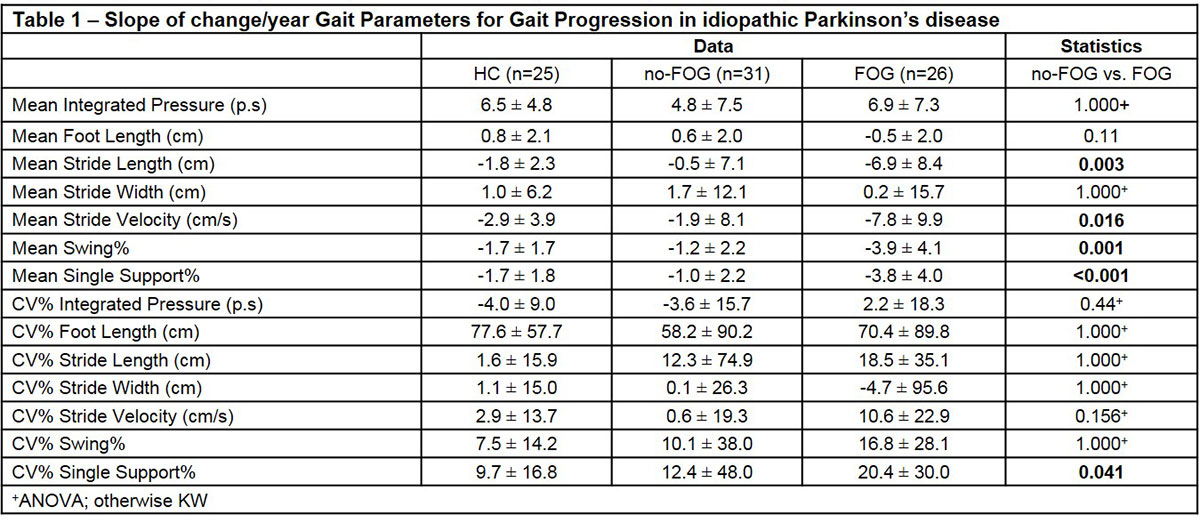Session Information
Date: Monday, September 23, 2019
Session Title: Other
Session Time: 1:45pm-3:15pm
Location: Agora 2 West, Level 2
Objective: To develop a predictive algorithm for freezing of gait (FOG) in Parkinson’s disease (PD) through longitudinal objective gait assessment.
Background: The presence of FOG results in a significant worsening in quality of life for PD patients. About 50% of PD patients develop FOG by 5 years of disease. To our knowledge only one prior study looked for differential change in spatiotemporal gait parameters longitudinally and found no difference between freezers and non-freezers. The ability to predict the development of FOG would allow us to test therapies to prevent development or slow progression.
Method: PD subjects with (FOG) and without (noFOG) freezing of gait and healthy controls (HC) were enrolled. Gait data was collected and analyzed using a 20’x4’ gait mat using PKMAS software (Protokinetics). Subjects walked 8 lengths at a comfortable pace every 3-6 months in the levodopa ON-state. The slope of change/year (delta) in gait parameters, and Unified Parkinson’s Disease Rating Scale (UPDRS), Freezing of Gait Questionaire (FOG-Q) and Montreal Cognitive Assessment (MoCA) scores were calculated for subjects completing at least 12-months of follow-up and 3 visits. Statistical analysis was performed using SPSS 24 (IBM).
Results: 82 enrolled subjects met criteria (26 FOG, 31 noFOG, and 25 HC). PD subjects had similar ages at enrollment (p=0.708) and follow-up visits (FOG 6.7±2.2, noFOG 6.4±2.2; p=1.0), but FOG subjects had a longer disease duration (FOG 9.2±5.8, noFOG 6.8±5.8 years; p=0.04). The delta FOG-Q, motor and total UPDRS were similar between PD groups. The FOG group had a decline in delta MoCA compared to noFOG (FOG -0.6±1.8, noFOG 0.3±1.9 score change/year; p=0.02). FOG subjects also had a faster decline in mean delta stride length, stride velocity, swing phase % and single support % compared to noFOG [Table 1]. For stride-to-stride variability (%CV), only delta %CV single support % was faster in the FOG group [Table 1]. There was a weak positive correlation between delta MOCA and delta mean stride velocity (p=0.03), swing phase % (p=0.03), and single support % (p=0.04).
Conclusion: FOG subjects demonstrate a differential decline in objectively quantifiable gait parameters over time, some of which correlated weakly with a decline in MoCA scores. Early detection of this differential regulation may help predict the development of FOG.
To cite this abstract in AMA style:
A. Glover, L. Pillai, S. Doerhoff, T. Virmani. Differential Gait Progression in idiopathic Parkinson’s disease with and without freezing of gait [abstract]. Mov Disord. 2019; 34 (suppl 2). https://www.mdsabstracts.org/abstract/differential-gait-progression-in-idiopathic-parkinsons-disease-with-and-without-freezing-of-gait/. Accessed December 27, 2025.« Back to 2019 International Congress
MDS Abstracts - https://www.mdsabstracts.org/abstract/differential-gait-progression-in-idiopathic-parkinsons-disease-with-and-without-freezing-of-gait/

